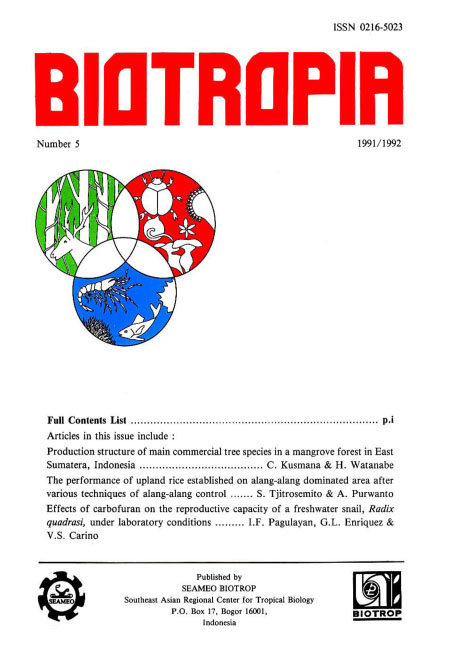
SEAMEO BIOTROP
Southeast Asian Ministers of Education Organization
940
views
Tags
EFFECTS OF CARBOFURAN ON THE REPRODUCTIVE CAPACITY OF A FRESHWATER SNAIL, RADIX QUADRASI, UNDER LABORATORY CONDITIONS
24 May 2019 - 02:21 pm (7 year ago)
Content Language : English
Content Language : English

Category :
Applied Science
The effects of 4 sublethal concentrations of carbofuran (250, 500, 1000 and 2000 ppm) on the
reproductive capacity of R. quadrasi was determined. Results showed that incubation period is delayed and
inhibited by 1000 and 2000 ppm carbofuran but not by lower concentrations. The hatching period is longer in
treated snails and not all eggs hatch in the 1000 and 2000 ppm treatment. The percentage of hatching is
inversely proportional to the carbofuran concentration.
Oviposition was delayed in all the treated stages and at all dosages. The higher the carbofuran
concentration, the later the onset of oviposition. The reproductive period is shortened. Fecundity was
decreased in snails treated at EMB and SM. However, only the 2000 ppm carbofuran concentration showed an
adverse effect on the snails exposure at PSM.
reproductive capacity of R. quadrasi was determined. Results showed that incubation period is delayed and
inhibited by 1000 and 2000 ppm carbofuran but not by lower concentrations. The hatching period is longer in
treated snails and not all eggs hatch in the 1000 and 2000 ppm treatment. The percentage of hatching is
inversely proportional to the carbofuran concentration.
Oviposition was delayed in all the treated stages and at all dosages. The higher the carbofuran
concentration, the later the onset of oviposition. The reproductive period is shortened. Fecundity was
decreased in snails treated at EMB and SM. However, only the 2000 ppm carbofuran concentration showed an
adverse effect on the snails exposure at PSM.
Link

This work is licensed under a Creative Commons Attribution-NonCommercial-NoDerivatives 4.0 International License.
